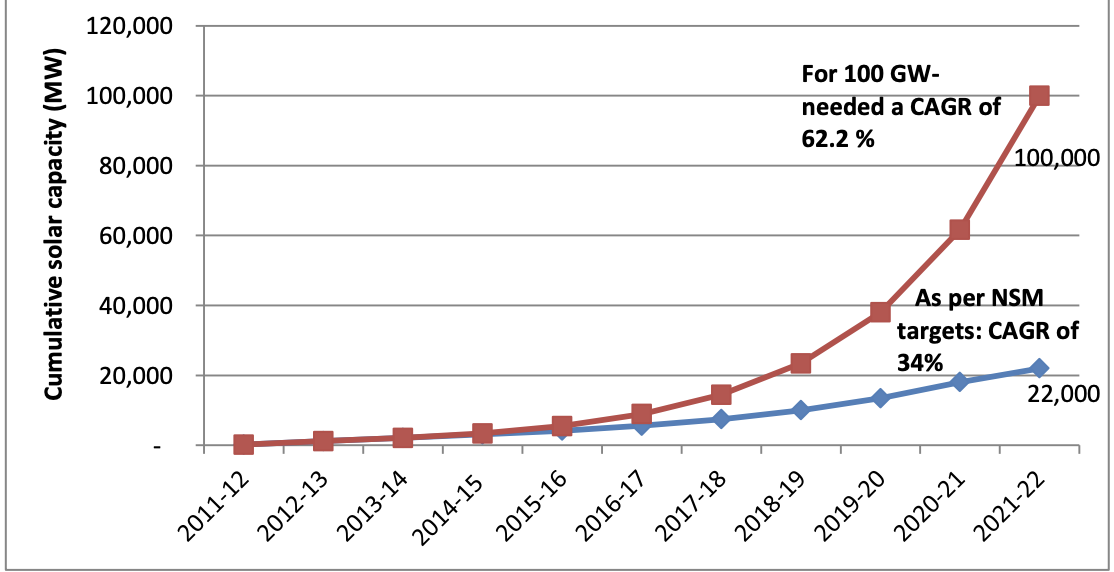Policy Brief
Tapping Every Ray of the Sun
A Roadmap for a significant role of Solar in India
Poulami Choudhury, Shalu Agrawal, Kanika Chawla, Rajeev Palakshappa, Karthik Ganesan, Arunabha Ghosh
October 2014 | Energy Transitions
Suggested Citation: Choudhury, Poulami, Shalu Agrawal, Kanika Chawla, Rajeev Palakshappa, Karthik Ganesan, and Arunabha Ghosh. 2014. Tapping Every Ray of the Sun: A Roadmap for a Significant Role of Solar in India. New Delhi: Council on Energy, Environment and Water.
Overview
This report assesses challenges that need to be addressed in order to scale up India’s solar capacity to 100 GW by 2022. It unpacks challenges such as high upfront costs, uncertainty of revenue generation and the lack of ease of doing business in detail. It also provides an overview of the key factors that drive investment in the solar sector. Further, it recommends action required for scaling up solar power in India.
Key Highlights
- India requires an investment of USD 140-160 billion to achieve the target of installing 100 GW of solar power by 2021-2022.
- In order to meet the target, a high compounded annual growth rate (CAGR) in solar capacity addition of 62.2 per cent would be required between 2014 and 2021-2022.
Growth Trajectory of Solar Power in India

Challenges to be addressed to scale Up to 100 GW by 2022
- The annual global manufacturing capacity of 50 GW could support India’s solar PV expansion plans until 2017-18 but would require a ramp up in the subsequent years.
- Solar imports worth USD 35.7 billion would be needed to install 100 GW by 2021-2022.
- Cost of finance is a major hindrance for utility-scale and non-residential rooftop solar projects. Easy access to finance is a hindrance for residential rooftop and rural decentralised projects.
- For utility-scale projects (> 10 MW size), the cost of connection with the nearest transmission line is at least 2.5 per cent of the overall project cost.
- Uncertainty of adequate revenue generation
- High levelised cost of electricity (LCOE) of solar in comparison to conventional fuels mean low demand for solar energy.
- The gap between LCOE and available tariffs can be filled through incentives such as preferential feed-in-tariffs (FiTs), generation-based incentives (GBI) or tariff rebates, each relevant for different types of solar installations.
- Exempting solar producers from charges such as wheeling and banking charges and cross-subsidy surcharges could increase the expected returns on investment.
- Lack of ease of doing business
- Investors cite lack of information about projects commissioned, power generation and irradiance as sources of rising risk perception.
- Lack of availability of skilled manpower also poses operational challenges as it directly impinges on project implementation and scale-up.
Key Recommendations
- Provide incentives as a combination of accelerated depreciation and generation-based incentives.
- Announce net metering policies and provision of a FiT for residential rooftop PV installations.
- Introduce differential subsidy for different sizes of solar pumps to give higher support to small and marginal farmers.
- Lease government land at concessional rates for project lifetime or 25 years, whichever is less (example Rajasthan).
- Build an evacuation infrastructure using the National Clean Energy Fund (NCEF). In addition, expedite the implementation of the Green Corridor project with a single window clearance facility, if necessary.
- Establish a Green Bank in order to provide low-cost loans with long term tenure, which can be initially capitalised by the NCEF. Also, include renewable energy within the priority sector lending.
- Establish single window clearance facility with time bound clearances (e.g., in Rajasthan).
- Design and institute a nationwide training program for solar technologies under the National Skill Development Council (NSDC). The per capita cost of training is approximately INR 9000.
- Design and institute a nationwide training program for solar technologies under the National Skill Development Council (NSDC). The per capita cost of training is approximately INR 9000.
A cumulative installed capacity of 100 GW of solar power by 2021-22 would help scale up India’s solar capacity to 9 per cent of total power demand.







